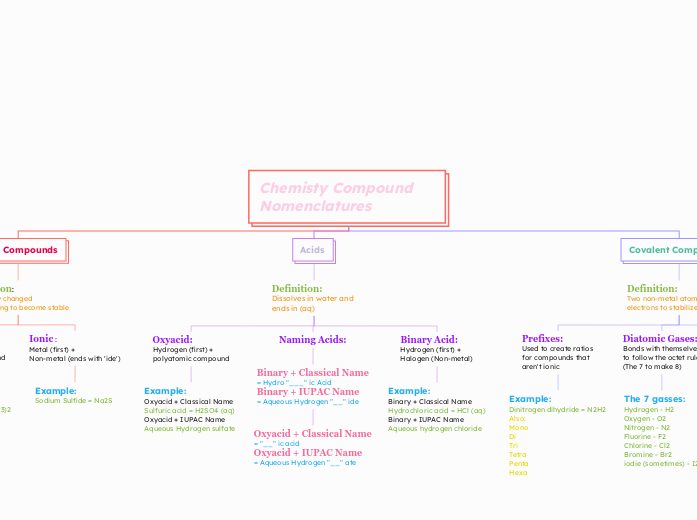Chemisty Compound Nomenclatures
Ionic Compounds
Definition:
Oppositely changed
ions bonding to become stable
Polyatomic Ion:
Metal (first) +
Polyatomic ion compound
(Back of periodic table)
Example:
Clacium Chlorate = Ca(ClO3)2
Ionic:
Metal (first) +
Non-metal (ends with 'ide')
Example:
Sodium Sulfide = Na2S
Acids
Definition:
Dissolves in water and
ends in (aq)
Oxyacid:
Hydrogen (first) +
polyatomic compound
Example:
Oxyacid + Classical Name
Sulfuric acid = H2SO4 (aq)
Oxyacid + IUPAC Name
Aqueous Hydrogen sulfate
Naming Acids:
Binary + Classical Name
= Hydro "___" ic Acid
Binary + IUPAC Name
= Aqueous Hydrogen "__" ide
Oxyacid + Classical Name
= "__" ic acid
Oxyacid + IUPAC Name
= Aqueous Hydrogen "__" ate
Binary Acid:
Hydrogen (first) +
Halogen (Non-metal)
Example:
Binary + Classical Name
Hydrochloric acid = HCl (aq)
Binary + IUPAC Name
Aqueous hydrogen chloride
Covalent Compounds
Definition:
Two non-metal atoms sharing
electrons to stabilize
Prefixes:
Used to create ratios
for compounds that
aren't ionic
Example:
Dinitrogen dihydride = N2H2
Also:
Mono
Di
Tri
Tetra
Penta
Hexa
Diatomic Gases:
Bonds with themselves
to follow the octet rule
(The 7 to make 8)
The 7 gasses:
Hydrogen - H2
Oxygen - O2
Nitrogen - N2
Fluorine - F2
Chlorine - Cl2
Bromine - Br2
iodie (sometimes) - I2
Memorize:
O3 - Ozone
H2O - Water
CH4 - Methane
NH3 - Ammonia
H2O2 - Hydrogen Peroxide
HONC Rule: Tells us the combining capacity
of atoms
H - Hydrogen + Halogens (form 1)
O - Oxygen + Sulfur (form 2)
N - Nitrogen + Phosphorus (form 3)
C - Carbon + Silicon (form 4)
